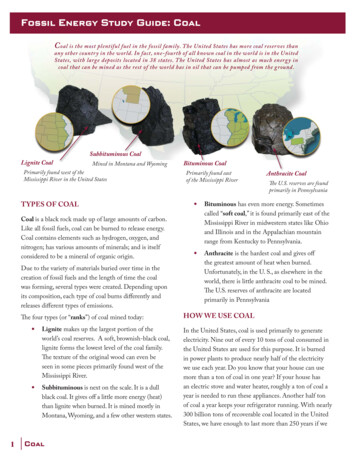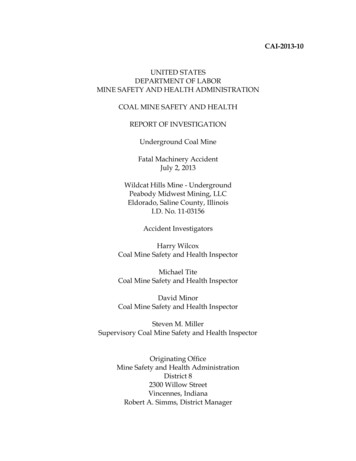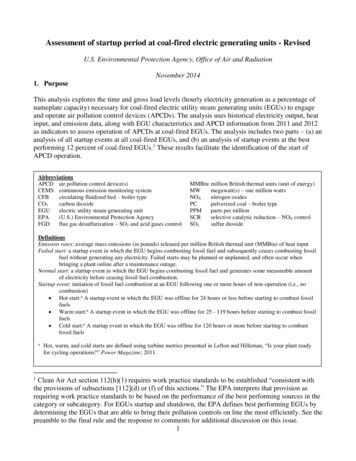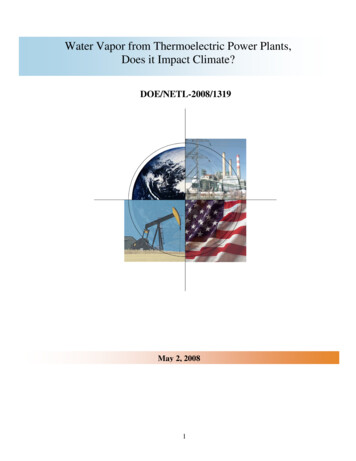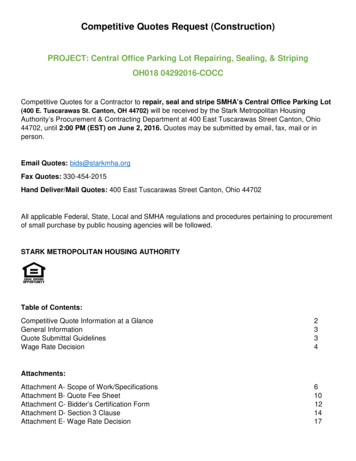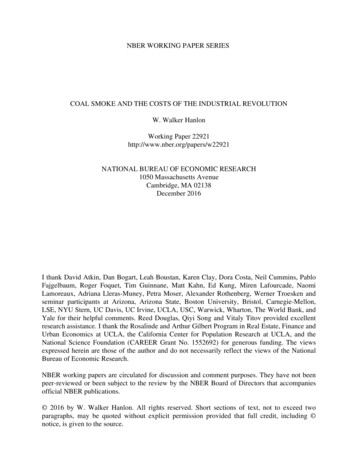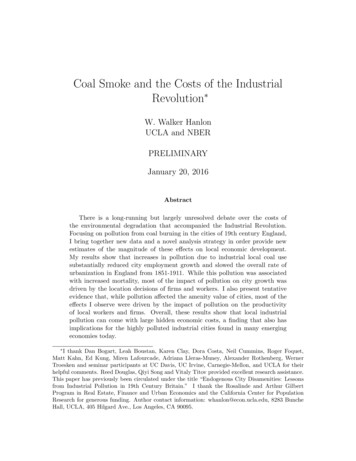
Transcription
Coal Smoke and the Costs of the IndustrialRevolution W. Walker HanlonUCLA and NBERPRELIMINARYJanuary 20, 2016AbstractThere is a long-running but largely unresolved debate over the costs ofthe environmental degradation that accompanied the Industrial Revolution.Focusing on pollution from coal burning in the cities of 19th century England,I bring together new data and a novel analysis strategy in order provide newestimates of the magnitude of these effects on local economic development.My results show that increases in pollution due to industrial local coal usesubstantially reduced city employment growth and slowed the overall rate ofurbanization in England from 1851-1911. While this pollution was associatedwith increased mortality, most of the impact of pollution on city growth wasdriven by the location decisions of firms and workers. I also present tentativeevidence that, while pollution affected the amenity value of cities, most of theeffects I observe were driven by the impact of pollution on the productivityof local workers and firms. Overall, these results show that local industrialpollution can come with large hidden economic costs, a finding that also hasimplications for the highly polluted industrial cities found in many emergingeconomies today. I thank Dan Bogart, Leah Boustan, Karen Clay, Dora Costa, Neil Cummins, Roger Foquet,Matt Kahn, Ed Kung, Miren Lafourcade, Adriana Lleras-Muney, Alexander Rothenberg, WernerTroesken and seminar participants at UC Davis, UC Irvine, Carnegie-Mellon, and UCLA for theirhelpful comments. Reed Douglas, Qiyi Song and Vitaly Titov provided excellent research assistance.This paper has previously been circulated under the title “Endogenous City Disamenities: Lessonsfrom Industrial Pollution in 19th Century Britain.” I thank the Rosalinde and Arthur GilbertProgram in Real Estate, Finance and Urban Economics and the California Center for PopulationResearch for generous funding. Author contact information: whanlon@econ.ucla.edu, 8283 BuncheHall, UCLA, 405 Hilgard Ave., Los Angeles, CA 90095.
1IntroductionThe Industrial Revolution represented a watershed in economic growth, yet there is along-running debate over the costs that industrialization imposed on the generationsthat lived through these events. Writers such as Engels (1845) describe cities blackened with thick smoke and urban slums crowded with diseased and dying people.Motivated by these contemporary observations, economic historians have sought tomeasure the external costs of industrial growth in 19th century British cities. Existing work on this topic, such as Williamson (1981b), suggests that the external costsof industrialization were not large, but these findings have been criticized for drawingbroad conclusions, which seem to contradict much of the contemporary evidence, fromrelatively sparse data (Pollard (1981)).1 As a result, at present this debate remainslargely unresolved.This study revisits this debate using new data and improved theoretical and econometric tools in order to provide new results that can bring us closer to resolution. Ifocus my attention on the impact of pollution generated by industrial coal burning inEnglish cities from 1851-1911. Coal smoke pollution was the most widespread negative externality associated with industrialization during this period, and it is naturalto focus on English cities because of the leading role that they played in the IndustrialRevolution. The temporal scope of this study covers the second half of the 19th century, a period in which industrialization and urbanization had become wide-spreadand the negative health effects of living in large cities peaked.My results imply that the pollution generated by industrial coal use substantiallyaffected the development of English cities during this period. Specifically, in Englishcities that experienced rapidly rising coal use, employment growth systematicallyunderperformed the growth that we would have expected given the initial mix ofindustries in each city and national industry growth rates. The magnitude of these1See also (Williamson, 1981a, 1982).1
effects was large; based on my estimates, over a two-decade period, a city in whichlocal industrial coal use grew at a rate that was one standard deviation above thenational average would, as a consequence, have experience a reduction in employmentgrowth of 12-20 percentage points, equal to one-third to one-half of the average growthin employment across two-decade periods.These results also imply that rising industrial coal use influenced the overall rateof urbanization in England during the second half of the 19th century. To assess themagnitude of these effects, I consider a counterfactual in which the growth rate ofindustrial coal use is reduced by ten percent without other economic effects. Underthis counterfactual I estimate that population in the 31 analysis cities in 1911 wouldhave been larger by about 1.5 million and the share of the English population in thesecities, which rose from 30% in 1851 to 34% in 1911, would instead have reached 38%in 1911, bringing the share of population in these cities closer to modern levels.Generating these results requires overcoming two major challenges. The firstis a lack of direct pollution measures in the period I study.2 To overcome this, Icombine data from the Census tracking the local composition of industries in thelargest English cities with information on the amount of coal used per worker in eachindustry. This allows me to construct estimates of local industrial coal use in 31cities for each decade for 1851-1911. These data show that there was large variationacross cities in the amount of industrial coal use, driven by the enormous variationin the coal use intensity of different industries, together with the uneven sorting ofindustries across locations.Another major challenge is presented by the lack of detailed wage and rent data2One consequence of the lack of pollution measures is that relatively little quantitative workhas been done studying the impact of pollution in the 19th century. One of the few exceptions isTroesken & Clay (2011), which studies the evolution of polluted fogs in London over time. Fouquet(2012) discusses long-run pollution trends in Victorian Britain. More evidence documenting theimpact of coal-based air pollution becomes available starting in the middle of the 20th century,including Barreca et al. (2014), Clay et al. (2015b), and Clay et al. (2015a). While quantitativestudies on this topic are somewhat sparse, qualitative evidence is provided by a rich set of historicalwork, including Mosley (2001), Thorsheim (2006), and Brimblecombe (1987).2
by location in the 19th century, which are generally needed to estimate the effectsof local pollution. To deal with this, I develop a new estimation approach that canbe implemented using only data on industry employment over time.3 This estimation approach is derived from a standard spatial equilibrium model, in the RosenRoback tradition, which has been modified to incorporate many industries that areheterogeneous in the intensity with which they use coal as an input. The level oflocal industrial coal use affects employment growth, either by reducing the consumeramenity value experienced by city residents, or by affecting the productivity of localfirms (through the of health workers, for example).4 An important feature of myestimation strategy is that it will capture effects on city growth operating througheither of these channels.This new estimation strategy is one important contribution of this paper. Thestrategy that emerges from my theory is closely related to the widely-used Bartik orshift-share instrument (Bartik (1991)), but differs from most existing studies in thisvein in that my estimation strategy is derived directly from the theory.5 Groundingthe estimation strategy in theory makes the assumptions underlying the estimationapproach more transparent and is helpful for interpreting the estimated coefficients.My main results raise several additional questions. For example, how much of theimpact of coal pollution on city growth was due to increased mortality? To answerthis question, I study the relationship between industrial coal use and mortality usingpanel data from 1851-1900. My results show that a one standard deviation increase3The set of existing studies looking at the impact of pollution on population migration includesBanzhaf & Walsh (2008) and Bayer et al. (2009).4While the amenity channel is the most straightforward, the impact of pollution on productivityhas been highlighted in several recent papers, including Hanna & Oliva (2015) and Graff Zivin &Neidell (2012).5The only other study that I’m aware of which provides a micro-founded motivation for the Bartikinstrument is Bartelme (2015). The main difference between Bartelme’s paper and the model in thisstudy is that in his study industries differ in a demand shift parameter while in this study they varyin their input shares. Having a theory that allows for variation in input shares is useful becausemany studies that use a Bartik instrument approach exploit industry-level variation in input use,for example, in the share of skilled to unskilled workers in an industry.3
in local industrial coal use increased the mortality rate by two deaths per thousand,or about 10%. These effects occurred primarily among the very young or those over35, and for adults the impacts were concentrated in respiratory diseases, the categorymost associated with air pollution. While these are substantial effects, they canexplain only about 4.4% of the overall relationship between rising coal use and citypopulation growth. This implies that most of the impacts I observe must be due tochanges in the location decisions of workers and firms.Another important question is whether the results I observe were driven by changesin the amenity value experienced by city residents or by changes in productivity.Using a cross-section of local wage, rent and price data from 1905, I provide tentativeevidence showing that workers were compensated with higher real wages in citieswith more industrial coal use, consistent with a negative consumer amenity effect.However, the magnitude of the compensation is not large, suggesting that most of thecity growth results I observe were driven by the impact of pollution on productivitywhich affected workers’ location decisions by changing the spatial distribution of jobopenings. These results, while tentative, fit recent studies providing evidence thateven low levels of pollution can impact productivity (e.g., Graff Zivin & Neidell (2012)and Hanna & Oliva (2015)) as well as evidence that the availability of employment wasthe central motivation for migration decisions in the 19th century (Pollard (1981)).6Could different policies have reduced the negative effects of pollution during thisperiod without substantially impeding economic growth? In the last part of thepaper, I draw on historical sources in order to shed some light on this question. Inparticular, I take advantage of a detailed study of coal use in Britain undertakenby a group of experts commissioned by Parliament and documented in the extensive1871 Coal Commission Report. This report argues that, “Without traveling beyondknown principles, it was thought that a considerable saving of fuel could be effected”6Graff Zivin & Neidell (2013) provide a useful review of the literature on the impact of pollutionon human capital and productivity.4
(p. 104). In particular, they highlight that large savings of coal could have beenachieved through simple improvements to how coal was fed into boilers and furnaces,by insulating boilers and steam engines to reduce lost heat, and by implementingavailable technologies for reusing hot air in furnaces. Most of these changes couldhave been achieved with relatively modest costs.Why, then, were these improvements not implemented? Three factors appear tohave been key. First, the costs of industrial pollution were largely external to firms,giving industrialists little direct incentive to use coal more efficiently. Second, cheapcoal prices reduced the incentives of producers to invest in technologies that usedcoal more efficiently. Third, limited and weak government regulation, a product ofthe strong laissez faire ideology that dominated British politics during this period, aswell as the political power of local industrialists, failed to provide strong incentivesfor investments in efficiency.These findings have implications for highly polluted industrial cities in moderndeveloping countries, where policymakers regularly face trade-offs between encouraging economic growth and protecting the local environment. In particular, my resultsshow that allowing industrial pollution can impose large – but often more difficult toobserve – economic costs on cities.These findings are related to several strands of the existing literature. There isa natural link to the large literature studying the health and environmental effectsof pollution, which is too large to review here.7 This literature has shown that evenlow levels of pollution can have important economic and health costs. Relative toexisting studies in this area, the novel contribution of this paper is to provide newdata and a new estimation framework that allows me to study the long-run costs ofindustrial pollution. There is also a natural connection between this paper and recentwork on endogenous city amenities. Existing work in this area considers endogenous7Within this literature, my study is most similar to Kahn (1999) and Chay & Greenstone (2003).See Graff Zivin & Neidell (2013) for one recent review.5
amenities related to the composition of city residents (Rauch (1993), Moretti (2004),Shapiro (2006), Diamond (Forthcoming)). In contrast, this paper highlights how theindustrial composition of cities can also affect city amenities through pollution.In the next section I describe the empirical setting. Data and measurement arediscussed in Section 3, followed by the theory, in Section 4. The main analysis ispresented in Section 5, while Section 6 provides a discussion of the potential forefficiency gains during this period. Section 7 concludes.2Empirical settingLandes (1998) describes the Industrial Revolution as composed of three elements:the replacement of human skill by machines, the introduction of engines to convertheat into work, and the substitution of mineral power sources – chiefly in the form ofcoal – for other power sources. One consequence of these changes was rapid growthin coal use by industry. British coal consumption averaged 65 million tons annuallyin 1852-1862 and rose to 181 million tons in the 1903-1912 period.8 This amountedto 4.3 tons per person in 1911.9 Most of this coal – 60-65 percent – was burned byindustry.10 Because some industries were particularly intensive users of coal, and theseindustries tended to agglomerate, industrial coal use could be highly geographicallyconcentrated. Also, before electricity transmission, power had to be generated on-siteat factories, which were located in urban areas where they could be reached on foot8These figures are from the U.K. Department of Energy and Climate Change.These figures are in imperial tons per year. For comparison, in 2012 the U.S. consumed about2.5 tons of coal per person annually, China consumed about 2.7 tons per person, and Australia, oneof the heaviest users, consumed around 5.8 tons per person. However, today most coal use occursin electricity generation plants outside of urban centers.10This includes mining, which is included in the industrial coal use measures used in this study.Data from Mitchell (1988). In contrast, residential coal use accounted for only 17-25 percent of domestic consumption, but attracted more attention because it was particularly important in London.The remainder is composed of use by transportation and utilities. it is worth noting that residentialcoal use was more polluting, per ton burned, than industrial coal use. This is because it was burnedless efficiently (at lower temperatures) and released at lower altitudes.96
by workers.The pollution released by coal burning factories was widely recognized and discussed. For example, The Times (Feb. 7, 1882, p. 10)11 wrote,There was nothing more irritating than the unburnt carbon floatingin the air; it fell on the air tubes of the human system, and formeda dark expectoration which was so injurious to the constitution; itgathered on the lungs and there accumulated.While pollution in London was more likely to be experienced by visitors and notedby the press, coal smoke pollution was particularly severe in the industrial cities ofEngland. For example, describing a visit to Northwest England in 1890, CannonHardwicke Drummond Rawnsley wrote,.chimneys, solid and square, were belching forth clouds of Erebeandarkness and dirt.The heavens were black with smoke, and thesmother of the mills, to one whose lungs were unaccustomed tobreathing sulphurised air, made itself felt.While the health effects of air pollution were not fully understood, there was anappreciation for the link between coal-based air pollution and poor health. This isillustrated in the 1867 report of the Sanitary Association by Dr. M.A. Morgan onManchester (reported by The Times, April 16, 1867), which stated that,the chief solid impurity of the air of Manchester is coal smoke, andits mode of action on the human body is of two kinds – (1), as anirritant to the lungs, producing bronchitis or assisting in the production and maintenance of this disease.and (2), by its sulpherettedhydrogen reducing the tone of the system, and rendering it easilysusceptible to zymotic [infectious] diseases.11Quoted from Troesken & Clay (2011). See that paper and Thorsheim (2006) for many otherexamples.7
Further evidence was provided by the wave of deaths that occurred when anticyclone weather systems resulted in particularly dense fogs, such as in 1880, when theBritish Medical Journal estimated that over 1000 excess deaths occurred in Londonin one week.12Beyond the health effects, coal smoke also had a myriad of other visible consequences. White cloths became stained and went out of style. Visibility was often soreduced that it caused traffic accidents. There is even evidence that pollution hadevolutionary effects. Kettlewell (1955) describes how the Lepidoptera moths, originally white, evolved to take on a dark gray color in order to blend into the pollutedforests near the northern industrial cities.There was a substantial amount of population mobility in England during thisperiod, with large flows of population from rural areas as well as Ireland and Scotlandinto English cities. While the search for work was the primary driver of these flows,there is also some evidence that pollution levels affected location decisions, bothwithin and across cities, as early as the 1840s. Engels (1845), wrote,These east and north-east sides of Manchester are the only ones onwhich the bourgeoisie has not built, because ten or eleven months ofthe year the west and south-west wind drives the smoke of all thefactories hither, and that is for the working people alone to breath.Similarly, in the 1880s Robert Holland wrote that, “[t]he rich can leave the sordidcity and make their homes in the beautiful country.the poor cannot do so. Theymust breath the stifling, smoky atmosphere.”13In addition to coping with rising pollution through relocation, there were alsoefforts to apply regulation. However, these efforts often ran up against the laissezfaire ideology that dominated British policy during this period, as well as the politicalpower of mill owners. New pollution regulations were passed, including The Sanitary1213British Medical Journal (Feb. 14, 1880, p. 254).Quoted from Thorsheim (2006).8
Act of 1866, The Public Health Act of 1875 , and The Public Health (London)Act of 1891. However, these acts allowed for substantial interpretation, containedimportant loopholes, and imposed relatively small fines.14 As a result, historicalevidence suggests that their effectiveness was limited, though they may have hadmore impact toward the end of the century.153Data and measurementThe first key piece of data for this study is a measure of local industrial composition.These data come from the Census of Population, which reports the occupation of eachperson at each ten-year census interval from 1851-1911 for 31 of the largest cities inEngland.16 The occupational categories reported in these data closely correspond toindustries, such as cotton spinner or steel manufacturer.17 To construct consistentseries for 1851-1911, I combine the many occupational categories available in eachcensus into a set of 26 broad industries, spanning nearly the entire private-sectoreconomy.18One feature that emerges from these data is that the spread of industries acrosscities was far from even. For example, textile producers agglomerated in cities inLancashire and Yorkshire, where they often accounted for one-quarter to one-third ofprivate-sector employment. Cities such as Sheffield, Birmingham and Wolverhamptonhad a disproportionate share of metals industries, while ports such as Bristol and14One example provided by Thorsheim (2006) is that the acts regulated “black smoke” and thatdefendants were able to avoid fines by claiming that their smokestacks emitted only dark brownsmoke.15See, e.g., Thorsheim (2006) and Fouquet (2012).16The set of cities in the database includes all of the English cities for which city-level occupationdata were reported by the Census for each decade from 1851-1911. Figure 2 in the Appendix includesa map of these cities.17One unique feature of this data source is that it comes from a full census rather than a sample.This is helpful in reducing the influence of sampling and measurement error.18For further details about these data see Hanlon & Miscio (2014) and the online appendix tothat paper.9
Liverpool had high shares of transportation and services.The second necessary piece of information for this study is a measure of the coalintensity of each industry. This information is drawn from the first Census of Production, which was completed in 1907.19 This Census collected detailed information onthe amount of coal used in each industry, as well as industry employment, allowingme to construct a measure of coal use per worker in each industry.20These data show that coal use intensity varied enormously across industries, afeature that plays a key role in this study.21 The most intensive industrial coal users,such as metal & machinery or earthenware & bricks, used coal to heat material upto high temperatures. These industries used more than forty tons per worker peryear. Textiles, a moderate coal-using industry which consumed around ten tons perworker per year, generally used coal to power steam engines. Other industries, suchas apparel or tobacco products, used very little coal, less than two tons per worker peryear. This large variation in coal use intensity at the industry level, together with thetendency of industries to agglomerate in particular locations, resulted in substantialvariation in the amount of industrial coal use at the city level.22This study will also draw on several useful auxiliary data sets. Data on mortalitypatterns in the cities I study, averaged across each decade, are available from theRegistrar General’s reports for 1851-1900.23 These data include the age at whichmortality occurred as well as the cause of death. I will also draw on a cross-sectionof data on local wages, rents and prices prepared by the Board of Trade. These datacover 51 cities in 1905.24Next, I discuss how the data are used to generate a measure of local industrial19While these data come from near the end of the study period, this is the earliest availableconsistent source for this information.20Coal and coke are combined in this study. In practice, coke consumption is small relative tocoal.21A table describing coal use intensity by industry is available in Appendix A.2.5.22Data describing the variation in industrial coal use across cities are available in Appendix A.2.6.23Further details are available in Appendix A.2.2.24For more information on the Board of Trade data, see Appendix A.2.3.10
pollution in each location and period. I model industrial coal use in cities as determined by city-industry employment (Lict ), the coal use intensity of each industry (θi ),and the national efficiency of coal use per worker, ρt :COALct ρtX(Lict θi ) .iEstimates of θi for manufacturing industries are provided by the 1907 Census ofProduction, while Census of Population data provide city-industry employment. Theρt term can be calculated by comparing data on industrial coal use at the nationallevel to the values obtained using data on θi and Lit .25 In general, other industries,such as services, were not likely to be major coal users, so this measure should capturemost industrial coal use.26One assumption implicit in this approach is that relative coal use per worker acrossindustries does not vary too much over time. While I cannot check for this over thestudy period, it is possible to check the extent to which industry coal use variesover time using data from the 1924 Census of Production, the next full productioncensus after 1907. Comparing coal use per worker in industries in 1924 to the samevalues in 1907 provides an assessment of how rapidly these industry features couldchange. This analysis, described in Appendix A.2.7, shows two results. First, the25P PSpecifically,I use the fact that ln(ρt ) ln(COALt ) ln ( c i Lict θi ) . In this equation,P Pthe c i Lict θi term can be calculated from the data, while national coal use in industry isavailable from Mitchell (1988). In practice, the inclusion of the ρt term will not affect the estimatedcoefficients because regressions are run on the log of coal use across locations within a period andthe ρt will be absorbed by year effects. However, this term will affect the overall impact of coal useon city growth.26An exception is local utilities, particularly gas, which was a major user of coal. Coal was usedto make gas, which was then pumped to users in the city, where it was burned for light or heat.Despite the fact that local utilities used coal, I exclude local utility coal use from the pollutionmeasure because gas providers may have reduced the amount of coal smoke residents were exposedto if the gas replaced more polluting forms of energy use in homes and offices. Another potentialexception is transportation, particularly rail transportation, which used a substantial amount ofcoal. However, most of this coal would have been burned outside of stations, spreading it thoughthe countryside. This makes it very difficult to determine the location of pollution related to coal usein the transportation sector. Thus, I also exclude transportation from the local coal use measure.11
relative coal use intensity across industries was remarkably stable over time. Thisis comforting, particularly because the 1907-1924 period saw larger changes in thesource of factory power, due to the introduction of electricity, than did the 1851-1907period. Second, comparing 1907 and 1924 coal use per worker suggests that there wasbroad improvement in coal use efficiency over time which occurred relatively evenlyacross industries. This type of efficiency improvement will be captured in the ρt term.Another assumption implicit in these coal use measures is that industry coal usedoes not vary too much across locations in response to variation in the relative levelof wages or coal prices. Put another way, it is important that variation in city coaluse due to local industry composition and differences in industry coal use intensityresulting from technological factors is substantially more important than the impactof variation in coal use driven by differences in the relative prices of labor and coal.This is a reasonable assumption given the massive variation in industry coal useintensity.One way to check both of these assumptions is to compare estimated levels ofcoal use calculated using the method described here to data on local coal use levels.While such data are often unavailable, there is information on county-level coal use inthe 1871 Coal Commission report. Comparing estimates of industrial coal use at thecounty level for 1871 to county-level coal use reported in the 1871 report, I find thatmy approach does a good job of replicating industrial coal use at the county level,particularly for more industrial and urbanized locations.27Estimates of industrial coal use per worker at the city level are described in Table8 in Appendix A.2.6. These data show that there was substantial variation acrosscities in the expected level of coal use per worker, even among similarly sized cities.Sheffield, often cited as the prototypical polluted industrial city, emerges as the mostintensive user of coal in the database, followed by other cities specializing in metals such as Birmingham and Wolverhampton. Textile manufacturing towns, such as27The full analysis is available in Appendix A.2.8.12
Manchester and Leeds, show moderate levels, near the average. Commercial and trading cities, such as Liverpool and Bristol, as well as London, use coal less intensively.Bath is the least polluted city in the database.4TheoryThis section presents a spatial equilibrium model in the Rosen-Roback tradition, butmodified in a few important ways in order to fit the empirical setting.28 The economyis made up of a fixed number of cities, indexed by c. These cities are small openeconomies that take goods prices as given. As is standard in spatial equilibriummodels, workers and firms can move freely across cities and goods are freely traded.I begin by modeling the demand for labor in cities.The ec
The Industrial Revolution represented a watershed in economic growth, yet there is a long-running debate over the costs that industrialization imposed on the generations that lived through these events. Writers such as Engels (1845) describe cities black-ened with thick smok
